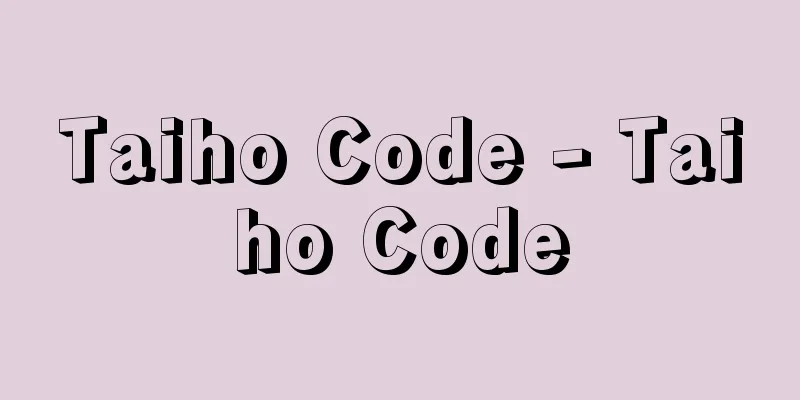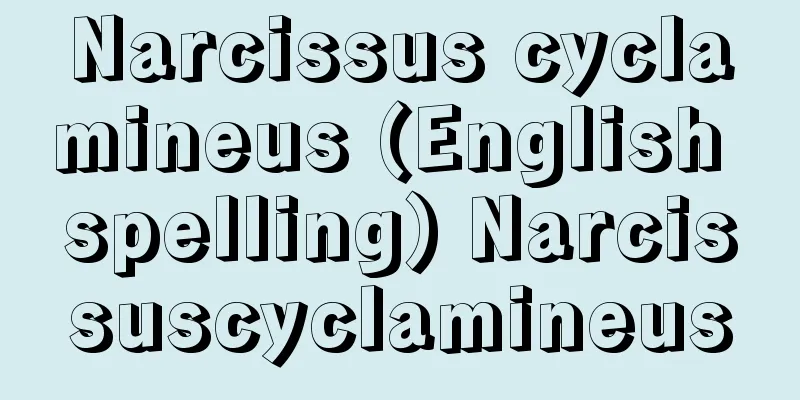Taiho Code - Taiho Code

|
An ancient Japanese law code. It is based on the Tang Dynasty's Eikiritsurei (651) and Eikiritsuso (653). Around the time Emperor Mommu ascended to the throne (697), the compilation of a new ritsuryo code began based on the Kiyomihara Code and the codes that had been compiled since the time of Emperor Tenmu. A censorship office was established for the compilation. The compilation was led by Prince Osakabe, Emperor Mommu's uncle, and Chunagon Fujiwara no Fuhito. The code was completed in March 700 (the 4th year of Emperor Mommu's reign), and the following year, in March 701, the era of Taiho was established, and the ranks (fifth rank and above) and the government system were revised in accordance with the new code. This marked the start of the enforcement of the Code. Revision of ranks below the sixth rank took place in May. Lectures on the Code were given to princes and other officials in April, to the Sogo priests in June, and to the provinces in August. General administration at the central and local levels was carried out according to the new Code from June. The first legal code compiled in Japan, the Taiho Code, was completed in August of 701 (Taiho 1) and distributed in February of the following year. This was the first time that both the Code and the Code were compiled. In 757 (Tenpyo Houji 1), the Yoro Code, compiled during the Yoro era (717-724), was enacted in place of the Taiho Code. The names Taiho Code and Yoro Code are academic terms that were later given. The Yoro Code is included in the official commentary Ryo no Gige (compiled in 833, implemented in 834) and the commentary on Ryo Gige, Ryo Shuge (compiled in the late 9th or early 10th century), which contains 28 chapters and 904 articles out of 30 chapters and 953 articles, and the rest has been almost completely restored. However, the Taiho Code was lost after the Yoro Code was enacted, and only fragments of its text have been restored so far from legal historical sources, mainly Ryo Shuge. While about one-third of the Yoro Code (about 500 articles) is known due to surviving copies, the Taiho Code has been scattered like the Ryo, and fragments of the text have been restored along with the scattered parts of the Yoro Code. According to the results of these studies on the restoration of the Taiho Code, although the Taiho Code has slightly different titles and the contents of the provisions differ in key areas, it is believed that the number and content of the provisions was basically the same as the Yoro Code. Furthermore, while the basic structure is the same as the Tang Code, the Ryo has been modified in many articles to suit the actual conditions in Japan, and the Ritsuryo has been modified in form by incorporating commentaries on the Ritsuryo, and the contents of the provisions have also been modified in the same way as the Ryo. [Eiichi Ishigami] "Inoue Mitsusada et al., eds., Japanese Thought Series 3: Ritsuryo (1976, Iwanami Shoten)" ▽ "Ritsuryo Research Group, eds., Japanese Ritsuryo Translation and Annotation, 10 volumes (1976-91, Tokyodo Publishing)" ▽ "New Revised and Supplemented National History Series: Ritsuryo Interpretation (1968, Yoshikawa Kobunkan)" ▽ "New Revised and Supplemented National History Series: Ritsuryo Collection Interpretation," 4 volumes (1972, Yoshikawa Kobunkan)" [Reference items] | | | |Source: Shogakukan Encyclopedia Nipponica About Encyclopedia Nipponica Information | Legend |
|
日本古代の法典。唐の永徽律令(えいきりつれい)(651)、永徽律疏(りつそ)(653)を藍本(らんぽん)とする。文武(もんむ)天皇の即位(697)前後から、浄御原令(きよみはらりょう)および天武(てんむ)天皇の時代から編纂(へんさん)が進められていた律をもとにして新たな律令法典の編纂が開始された。編纂には撰令所が設置された。編纂は文武天皇の叔父の刑部(おさかべ)親王、中納言(ちゅうなごん)藤原不比等(ふひと)らを中心にして行われた。700年(文武天皇4)3月に令が完成し、翌701年3月大宝と建元し、位階(五位以上)と官制を新令に従って改正した。これが令の施行の開始である。六位以下の位階改正は5月に行われた。4月には親王以下官人に、6月には僧綱(そうごう)に、8月には諸国に対して令の講義が行われた。中央・地方の一般行政は6月から新令により執行された。日本で編纂された最初の律法典である大宝律は701年(大宝1)8月に完成し翌年2月に頒行された。ここに初めて令律二法典がそろったのである。 757年(天平宝字1)には養老(ようろう)年間(717~724)に撰修(せんしゅう)された養老律令が大宝律令にかわって施行された。なお、大宝律令・養老律令の名称は後代に付された学術用語である。養老令は、その官撰注釈書の『令義解(りょうのぎげ)』(833撰、834施行)と『令義解』の注釈書の『令集解(しゅうげ)』(9世紀後半または10世紀初頭撰)に30篇(ぺん)953条のなかの28篇904条が収載され、残りもほぼ復原されている。しかし、大宝令は、養老令の施行以後散逸してしまい、現在はその逸文が『令集解』を中心とした法制史料により断片的に復原されているにすぎない。律は、養老律(約500条)がその写本の伝存により約3分の1ほど知られるのに対して、大宝律は令と同様に散逸してしまい、養老律の散逸部分とともに断片的に逸文が復原されている。これらの大宝律令復原研究の成果によると、大宝律令は令の篇名が若干異なり、また要所において条文の内容に違いがあるものの、条文数・条文内容ともに基本的には養老律令と同様のものであったと考えられる。また唐律令とは基本構成は同じであるが、令は日本の実状にあわせてきわめて多くの条文において改変が施され、律も律に律疏を組み入れるという体裁の変更を行うとともに条文内容でも令と同様に改変が施されている。 [石上英一] 『井上光貞他編『日本思想大系3 律令』(1976・岩波書店)』▽『律令研究会編『訳註日本律令』全10巻(1976~91・東京堂出版)』▽『『新訂増補国史大系 令義解』(1968・吉川弘文館)』▽『『新訂増補国史大系 令集解』全4巻(1972・吉川弘文館)』 [参照項目] | | | |出典 小学館 日本大百科全書(ニッポニカ)日本大百科全書(ニッポニカ)について 情報 | 凡例 |
<<: Crime of arrest and confinement
Recommend
Diagonal
〘noun〙① A line segment obtained by connecting two ...
Skiathos (English spelling)
…As the name Sporades means, it is made up of rel...
Carlo Felice
… French rule in Piedmont from 1796 to 1814 laid ...
Elysion (English spelling)
In Greek mythology, paradise is a place where huma...
Borowski, T.
...As a result, postwar literature was always sub...
Impact Crusher
...It is widely used for crushing raw materials i...
Cerano (English spelling)
Around 1575 - 1632 Italian painter. His real name ...
Kingdom of Burundi - Burundi Kingdom
A kingdom in the interior of East Africa, in what ...
December 9th Movement (English spelling)
On December 9th, 1935, a demonstration against Jap...
Spanish mackerel (English spelling)
...Also, because "shun" means spring, t...
Enyō (English spelling)
…the Roman goddess of war. She was considered the...
The Imperial Chronicles
A chronicle that lists the main events for each re...
Anrakuji Temple (Fukuoka) - Anrakuji
…However, because these Kyushu Tandai were all fo...
Asamukoiri - Asamukoiri
…Although the marriage form was essentially a bri...
Polesye (English spelling)
The largest marshland in Europe, straddling both B...







![Rendaiji Temple [Hot Springs] - Rendaiji Temple](/upload/images/67cd377199a96.webp)

